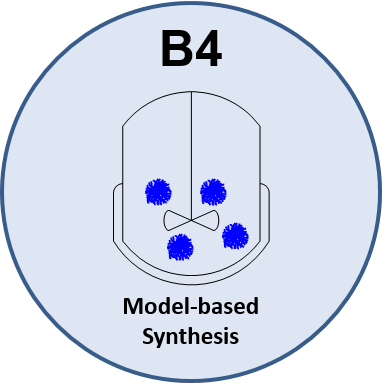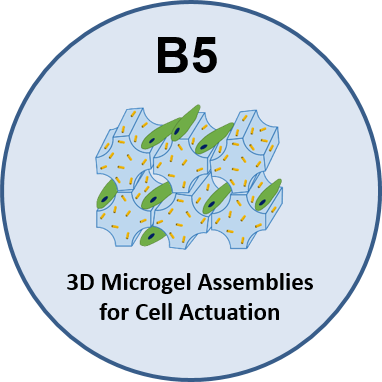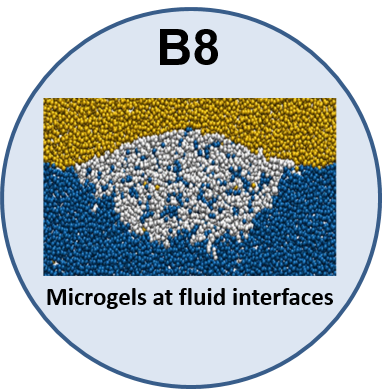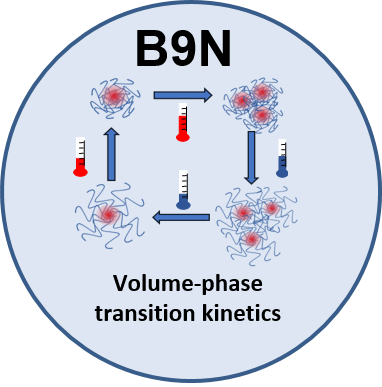Project Area B
Model-based product-process design of microgels
The goal for area B in the third period is to continue to progress towards model-based process-product design. Our successful example of an optimal operation for the synthesis of ferrocene-containing microgels concerns a rather simple polymerization process (batch and semi-batch) and a microgel that, while containing a complex comonomer, still has a relatively simple morphology. This successful collaborations within the SFB give us confidence that our developed tools can be used to tackle the next challenges. In particular, we aim to consider the both processes (polymerization and separation) for microgels including new comonomers with different functionality as well as with complex shapes and internal structure and, as a final step, the transition to entirely continuous reactors. To do so, we will utilize the synergy between simulations and experiments, and also the equipment and techniques developed.
Project B4 focuses on the development of dynamic mechanistic models for the synthesis of stimuli-responsive microgels combining model-based design with experiments and first-principle predictions to derive predictive reactor and microgel population models. In the new funding period, the focus will be on the synthesis of compartmentalized microgels (ionic or hydrophobic domains) with tunable internal structure, size and shape. This will be realized either by using kinetically-controlled (difference in the monomer reactivity) or phase separation-driven (incompatibility of polymer segments) structure formation in semi-batch and continuous precipitation polymerization. We will utilize the model to determine novel synthesis procedures while still using experimental results for continued model validation and adaptation. Modeling of the more complex microgel structures requires the prediction of reaction rate coefficients under difficult conditions (presence of ionic species, multiple (micro) phases and interfaces) and will be realized by a combination of cluster continuum models, reactive and non-reactive molecular dynamics simulations, and quantum mechanics.
Project B5 is concerned with designing 3D macroporous, responsive constructs via anisometric microgel assembly in order to actuate cells and study tissue engineering and mechanobiology. Anisometric microgel building blocks will be synthesized and their internal structure (nanoporosity), mechanical properties, and photo-thermal or magnetic responsiveness characterized and further optimized for cell culture. The assembly of the microgels with unique anisometric shapes and controlled dimensions and aspect ratios into suitable 3D macroporous tissue engineering scaffolds will be investigated to support and guide healthy cell growth, while exhibiting sufficient porosity for transport of nutrients to the cells. As microgels are swollen structures, they can respond to external triggers, depending on their chemical composition, loaded nanoparticles, and internal structure. This combination will be explored to trigger photo-thermal and magnetic actuation of the 3D assembly to determine mechanobiological consequences on the cells.
Project B8 investigates microgels at oil-water interfaces and will in particular study the structure of dense monolayers to understand how softness and connectivity of a microgel determine its assembly at the interface and how microgels respond to compression in 2D, i.e. via deswelling, interpenetration or deformation. This provides a perfect link to project A3, where assembly and crowding are investigated in 3D. Furthermore, B8 will investigate anisotropic microgels, which are now available in the SFB. We expect that the anisotropy of the microgels will lead to richer and more complex behavior at fluid interfaces such as, e.g., the formation of liquid crystalline structures, and ordering phenomena such as, e.g., tip-to-tip vs. side-by-side assemblies.
The new project B9N investigates the volume phase transition kinetics of microgels over a very broad range of time scales ranging from microseconds to hours using time-resolved light scattering, optical transmission, and fluorescence
experiments, complemented by small-angle X-ray scattering, small-angle neutron scattering, and highspeed video microscopy. Volume phase transitions will be induced by temperature-, pH- and solvent composition jumps. With the expertise established in the SFB it will be possible to cover a large range of microgel sizes, and the related diffusion and polymer relaxation times will accordingly range over many orders of magnitude. The aim is to determine the relaxation mechanisms and relaxation times of the microgels over a wide range of length and time scales to obtain a fundamental mechanistic understanding of the volume phase transition kinetics.




